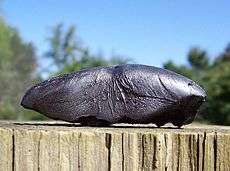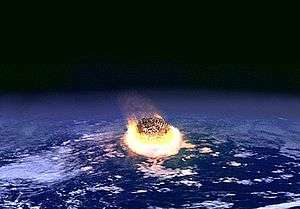Sikhote-Alin meteorite
| Sikhote-Alin | |
|---|---|
|
Thumbprinted Sikhote-Alin sample | |
| Type | Iron |
| Structural classification | Octahedrite, coarsest |
| Group | IIAB |
| Composition | 93% Fe, 5.9% Ni, 0.42% Co, 0.46% P, 0.28% S |
| Country | Russia |
| Region |
Sikhote-Alin Mountains, Primorsky Krai, Far Eastern Federal District |
| Coordinates | 46°09′36″N 134°39′12″E / 46.16000°N 134.65333°ECoordinates: 46°09′36″N 134°39′12″E / 46.16000°N 134.65333°E[1] |
| Observed fall | Yes |
| Fall date | February 12, 1947 |
| TKW | >28 tonnes (31 short tons)[1] (est. 70 metric tons[2]) |
| Strewn field | Yes |
An iron meteorite fell on the Sikhote-Alin Mountains, in southeastern Russia, in 1947. Though large iron meteorite falls had been witnessed previously and fragments recovered, never before in recorded history had a fall of this magnitude been observed.[3] An estimated 70 tonnes (metric tons) of material survived the fiery passage through the atmosphere and reached the Earth.[2]
Impact

At around 10:30 on 12 February 1947, eyewitnesses in the Sikhote-Alin Mountains, Primorye, Soviet Union, observed a large bolide brighter than the Sun that came out of the north and descended at an angle of about 41 degrees. The bright flash and the deafening sound of the fall were observed for 300 kilometres (190 mi) around the point of impact not far from Luchegorsk and approximately 440 km (270 mi) northeast of Vladivostok. A smoke trail, estimated at 32 km (20 mi) long, remained in the sky for several hours.
As the meteor, traveling at a speed of about 14 km/s (8.7 mi/s), entered the atmosphere, it began to break apart, and the fragments fell together. At an altitude of about 5.6 km (3.5 mi), the largest mass apparently broke up in a violent explosion called an air burst.
On November 20, 1957[4] the Soviet Union issued a stamp for the 10th anniversary of the Sikhote-Alin meteorite shower. It reproduces a painting by P. I. Medvedev, a Soviet artist who witnessed the fall: he was sitting in his window starting a sketch when the fireball appeared, so he immediately began drawing what he saw.[5]
Orbit
Because the meteor fell during daytime, it was observed by many eyewitnesses. Evaluation of this observational data allowed V. G. Fesenkov, then chairman of the meteorite committee of the USSR Academy of Science, to estimate the meteoroid's orbit before it encountered the Earth. This orbit was ellipse-shaped, with its point of greatest distance from the sun situated within the asteroid belt, similar to many other small bodies crossing the orbit of the Earth. Such an orbit was probably created by collisions within the asteroid belt.
Size
Sikhote-Alin is a massive fall with the overall size of the meteoroid estimated at approximately 90,000 kg (200,000 lb). A more recent estimate by Tsvetkov (and others) puts the mass at around 100,000 kg (220,000 lb).[6]
Krinov had estimated the post-atmospheric mass of the meteoroid at some 23,000 kg (51,000 lb).
Strewn field and craters
The strewn field for this meteorite covered an elliptical area of about 1.3 km2 (0.50 sq mi). Some of the fragments made impact craters, the largest of which was about 26 m (85 ft) across and 6 m (20 ft) deep.[7] Fragments of the meteorite were also driven into the surrounding trees.
Composition and classification

The Sikhote-Alin meteorite is classified as an iron meteorite belonging to the chemical group IIAB and with a coarse octahedrite structure. It is composed of approximately 93% iron, 5.9% nickel, 0.42% cobalt, 0.46% phosphorus, and 0.28% sulfur, with trace amounts of germanium and iridium. Minerals present include taenite, plessite, troilite, chromite, kamacite, and schreibersite.
Specimens
Specimens of the Sikhote-Alin Meteorite are basically of two types:[6]
- individual, thumbprinted or regmaglypted specimens, showing fusion crust and signs of atmospheric ablation
- shrapnel or fragmented specimens, sharp-edged pieces of torn metal showing evidence of violent fragmentation
The first type probably broke off the main object early in the descent. These pieces are characterized by regmaglypts (cavities resembling thumb prints) in the surface of each specimen. The second type are fragments which were either torn apart during the atmospheric explosions or blasted apart upon impact on the frozen ground. Most were probably the result of the explosion at 5.6 km (3.5 mi) altitude.
A large specimen is on display in Moscow. Many other specimens are held by Russian Academy of Science and a great number of smaller specimens have made their way into the collector's market.
- Thumbprinted individual
 Oriented individual
Oriented individual Shrapnel sample
Shrapnel sample
See also
- Glossary of meteoritics
- Meteorite
- Meteorite fall
- 2013 Russian meteor event
- List of meteor air bursts
References
- 1 2 Meteoritical Bulletin Database: Sikhote-Alin. Archived from the original on 2012-01-30.
- 1 2 Norton, O. Richard; Chitwood, Lawrence A. (2008). Field Guide to Meteors and Meteorites. London: Springer-Verlag. p. 47. ISBN 9781848001572.
- ↑ Norton, O. Richard (1998). Rocks From Space. Missoula, Montana: Mountain Press. p. 103. ISBN 0878423028.
- ↑ Burns, Philip R. "Pib". "Meteorite Stamps and Coins". Archived from the original on 2000-01-21.
- ↑ "Sikhote Alin". Planetarium de Montreal. Archived from the original on 2006-05-21.
- 1 2 Gallant, Roy (February 1996). "Sikhote-Alin Revisited". Meteorite Magazine. Arkansas Center for Space and Planetary Sciences, University of Arkansas. Archived from the original on 2010-06-12.
- ↑ "Sikhote-Alin". Earth Impact Database. University of New Brunswick. Retrieved 2009-08-19.
External links
| Wikimedia Commons has media related to Sikhote-Alin meteorite. |
- "Exposition "Meteorites"". Fersman Mineralogical Museum. Moscow, Russia: Russian Academy of Sciences.

